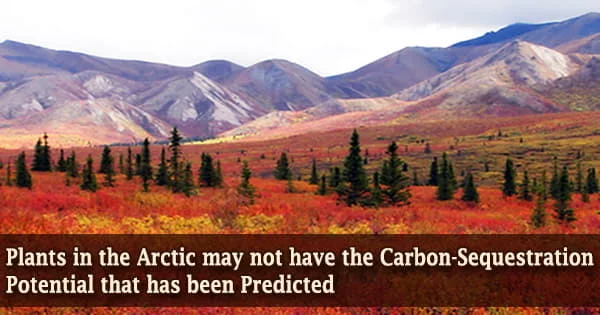According to a recent study from the University of Stirling, the environmental benefits of taller, shrubbier tundra plants in the Arctic may be exaggerated.
According to current ecological and climate models, tundra ecosystems are becoming more productive as the Arctic warms, with increased photosynthesis resulting in more carbon being taken, or sequestered, from the atmosphere.
Most models, on the other hand, ignore the transit and destiny of this carbon below ground, as well as how it interacts with soil carbon via soil microbes’ activities. This is crucial since the great majority of carbon in Arctic ecosystems is found in the form of organic matter created by the incomplete breakdown of dead plants, animals, and soil organisms in freezing temperatures in soil and ‘permafrost’ (permanently frozen soil or sediment).
The new study looked at the influence of a shrubbier Arctic on soil carbon stores and the ecosystem’s total carbon sequestration capability. Significantly, it was shown that some tall shrub communities induce carbon recycling in soils, releasing carbon dioxide back into the atmosphere, implying that more productive shrubs may not necessarily result in increased carbon sequestration.
A warmer, greener Arctic may increase the rate that carbon dioxide is removed from the atmosphere, our research identified an acceleration in the rate of loss of carbon from soils, back into the atmosphere.
Professor Philip Wookey
The Natural Environment Research Council (NERC) sponsored research initiative, of which this study was a part, was conducted by Professor Philip Wookey of the University of Stirling’s Faculty of Natural Sciences. Dr. Jens-Arne Subke, a Stirling colleague, was also involved in this research.
Professor Wookey said: “While previous studies suggest that a warmer, greener Arctic may increase the rate that carbon dioxide is removed from the atmosphere, our research identified an acceleration in the rate of loss of carbon from soils, back into the atmosphere.”
This might more than compensate for carbon sequestration, turning these ecosystems into a net release of carbon dioxide into the atmosphere. Significantly, existing ecosystem and climate models do not account for this paradox, implying that future climate feedbacks from Arctic ecosystems may be underestimated.
Dr. Lorna Street of the University of Edinburgh’s School of GeoSciences led the research, which included scientists from the NERC Radiocarbon Facility in East Kilbride, as well as Durham and Liverpool universities. The Aurora Research Institute, Wilfrid Laurier University, and the University of Montreal, all in Canada, provided further funding.
Fieldwork in the Mackenzie Uplands in the Northwest Territories, Canada, in 2013 and 2014 looked at how carbon is cycling in plants and soils over the last 50 years.
The researchers discovered evidence that birch bushes in the Arctic tundra are closely connected to the release of ancient carbon fixed by photosynthesis and stored in soil organic matter more than 50 years ago. This was not the case with alder, a different form of Arctic plant.
Dr Street said: “We think this is because, in birch, the products of photosynthesis are transferred to the soil through fungal symbionts, which stimulate the decomposition of soil organic material as a means of releasing the nutrients, like nitrogen, that the birch shrubs require to grow.”
Photosynthesis products are generally maintained in plant tissues in alder, however, because alder frequently has the assistance of microorganisms in the roots that can ‘fix’ nitrogen straight from the atmosphere.
“These findings indicate that, if as evidence has suggested shrub birch proliferates in tundra ecosystems over the next decades, this might directly stimulate the loss, through accelerated decomposition, of pre-existing soil carbon as carbon dioxide.”
The amount of potential carbon emission from high-latitude permafrost systems is unknown, with estimates ranging from 0 to 200 gigatons. For comparison, 200 Gt equals around 20 years of current total global carbon emissions to the environment owing to human activities.
Dr. Street added: “If our results apply across permafrost tundra regions, this suggests there is a previously unaccounted for the process which could push the system towards the upper end of those predictions. This is hugely important as it means we may need to do more than currently expected, in terms of carbon dioxide emissions reductions, to meet our climate targets.”
















